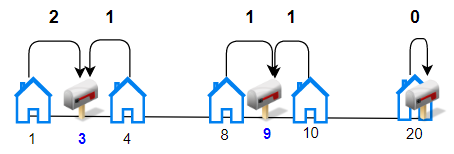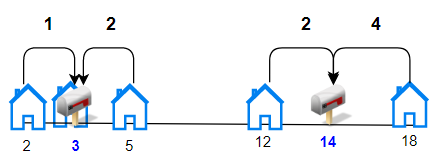1478.Allocate Mailboxes¶
Tags: Hard Dynamic Programming
Links: https://leetcode.com/problems/allocate-mailboxes/
Given the array houses and an integer k. where houses[i] is the location of the ith house along a street, your task is to allocate k mailboxes in the street.
Return the minimum total distance between each house and its nearest mailbox.
The answer is guaranteed to fit in a 32-bit signed integer.
Example 1:

Input: houses = [1,4,8,10,20], k = 3
Output: 5
Explanation: Allocate mailboxes in position 3, 9 and 20.
Minimum total distance from each houses to nearest mailboxes is |3-1| + |4-3| + |9-8| + |10-9| + |20-20| = 5
Example 2:

Input: houses = [2,3,5,12,18], k = 2
Output: 9
Explanation: Allocate mailboxes in position 3 and 14.
Minimum total distance from each houses to nearest mailboxes is |2-3| + |3-3| + |5-3| + |12-14| + |18-14| = 9.
Example 3:
Input: houses = [7,4,6,1], k = 1
Output: 8
Example 4:
Input: houses = [3,6,14,10], k = 4
Output: 0
Constraints:
n == houses.length1 <= n <= 1001 <= houses[i] <= 10^41 <= k <= n- Array
housescontain unique integers.
class Solution {
public:
int minDistance(vector<int>& houses, int m) {
std::ios_base::sync_with_stdio(false);
cin.tie(NULL);
cout.tie(NULL);
sort(houses.begin(), houses.end());
int n = houses.size();
vector<vector<int>> d(n + 1, vector<int>(m + 1, INT_MAX / 2)), f(n + 1, vector<int>(n + 1, 0));
for (int i = 1; i < n; ++i) {
for (int j = i + 1; j <= n; ++j) {
f[i][j] = f[i][j - 1] + houses[j - 1] - houses[((i + j) >> 1) - 1];
}
}
for (int i = 1; i <= n; ++i) d[i][1] = f[1][i];
for (int i = 1; i <= n; ++i) {
for (int j = 2; j <= i && j <= m; ++j) {
for (int k = j - 1; k < i; ++k) {
d[i][j] = min(d[i][j], d[k][j - 1] + f[k + 1][i]);
}
}
}
return d[n][m];
}
};
很典型的区间DP,原型是洛谷-P4677 山区建小学,时间复杂度O(n^3)。
用d[i][j]代表前i个房子建立j个邮筒的最小距离总和,f[i][j]代表从第i个房子到第j个房子只建立一个邮筒的最小距离和。
f[i][j]的状态转移方程:
f[i][j] = f[i][j - 1] + houses[j - 1] - houses[((i + j) >> 1) - 1];
考虑三个房子1,2,3。那么最优选择是建立在2,当多了一个房子4,其实还是建在2,那么只是多出了4到2的距离。
如果原来是1,2,3,4。最初是建在2和3都一样,一开始肯定建在(1 + 4) / 2的位置,也就是2,现在多了一个房子5,那么最优选择是建在3,前四个的距离是没有变化的,仍然只是多出了5到3的距离,也就是上面表达式的内容。注意下标的对应关系。
d[i][j]的状态转移方程:
d[i][j] = min(d[i][j], d[k][j - 1] + m[k + 1][i]);
表示前k个房子建立j-1个邮筒,第k+1个房子到i建立一个邮筒。